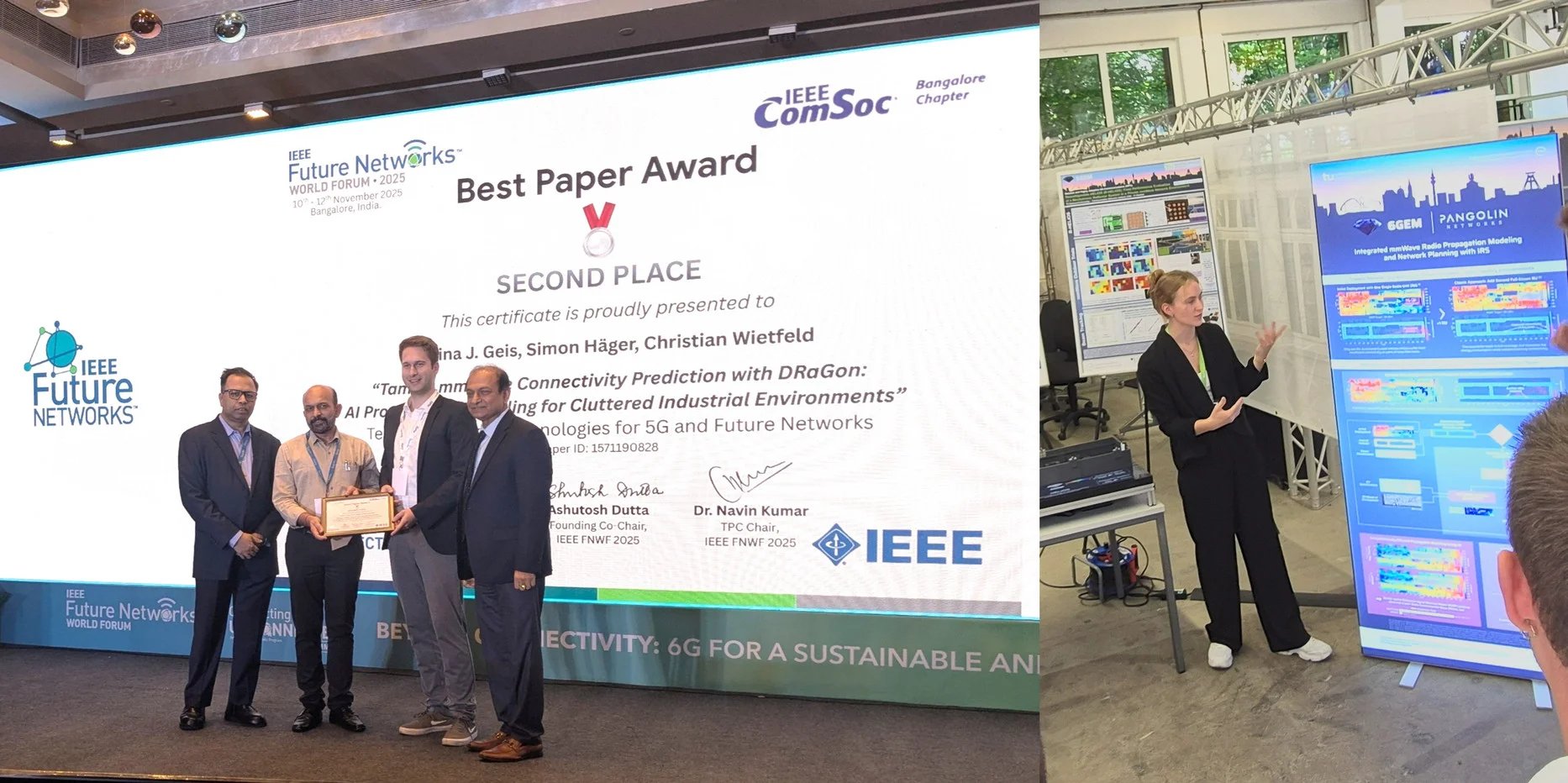6G Research on DRaGoN receives new best paper award at the IEEE Future Networks World Forum 2025

The Chair for Communication Networks of TU Dortmund (ComNets Dortmund) presented three papers at this year's Future Networks World Forum, which took place in Bangalore, India, in November 2025.
The first paper, which won the award, has been co-authored by Melina Geis, Simon Häger and Christian Wietfeld and addresses the prediction on mmWave channel characteristics: Future 6G industrial networks will require very high data rates and thus rely heavily on mmWave frequencies, whose propagation is complex and sensitive to obstacles. Accurate planning therefore depends on high-quality Radio Environmental Maps, which need precise channel models. Traditional models are either too slow or not accurate enough; ML approaches are promising but have not yet been applied to large, cluttered indoor factory environments. The paper introduces an ML-based propagation model for a densely cluttered real industrial site, using privacy-preserving environmental features (top- and side-view projections). Two model types, LGBM and ANN, are trained on measurements from the factory. Both models capture key propagation effects, outperform empirical models by 8.18 dB RMSE, and run about 30× faster than ray tracing. The results show that ML models can generate fast and reliable mmWave connectivity maps, enabling efficient 6G network planning in industrial environments.
- M. Geis, S. Häger, C. Wietfeld, "Taming mmWave Connectivity Prediction with DRaGon: AI Propagation Modeling for Cluttered Industrial Environments," in IEEE Future Networks World Forum (FNWF), Bangalore, India, November 2025 (awarded with 2nd Best Paper Award). [pdf]
The second paper proposes a complete process for an integrated 6G network design with the custom-tailored HELIOS reflector invented at ComNets Dortmund: Private mmWave networks can deliver very high data rates for indoor factory environments but suffer in NLOS areas, where attenuation can severely degrade connectivity. The usual countermeasure - deploying more base stations - raises cost and energy usage. Future 6G systems aim to mitigate this through intelligent reflecting surfaces (IRSs), with the passive-static HELIOS IRS already demonstrating strong practical maturity and proven link improvements in field tests. The paper develops a systematic brownfield planning approach to determine how many IRSs are needed, where to place them, and how to preconfigure their reflection behavior. Using a real production environment, it shows that a single base station combined with three carefully positioned passive HELIOS IRSs can maintain the required service quality, effectively replacing the need for a second active base station. This contributes a key step toward hybrid 6G network planning that integrates IRSs efficiently.
- S. Häger, M. Geis, K. Sabanovic, P. Jörke, S. Böcker, C. Wietfeld, "6G Network Design with Custom-tailored IRSs for Sustainable Millimeter-wave Connectivity Enhancements in Industrial Environments," in IEEE Future Networks World Forum (FNWF), Bangalore, India, November 2025. [pdf]
The third paper is a joint work on real-time robotics control via 6G was jointly authored by members of the teams of ComNets Dortmund with the DAES team from Computer Science. Disaster-relief robotics depends heavily on low network latency, as delays can undermine mission success. The paper examines two scenarios with different latency demands: Chemical Hazard Control, which prioritizes immersive operator experience, and Catching the Falling Rod, which requires strict real-time responsiveness. Both are evaluated under controlled latency conditions, and the second scenario is additionally tested on the ComNets Dortmund Open RAN-based 6G research platform to analyze suitable ROS 2 deployment strategies. A 100 ms latency increase severely degrades performance in the first scenario, lengthening task completion by 50% and raising the failure rate by a factor of four. The second scenario shows that proactive scheduling is necessary to satisfy its tight real-time constraints. Overall, the study confirms that 6G-class ultra-reliable low-latency capabilities are essential for effective robotic control in disaster-response missions.
- M. Patchou, C.-C. Lin, N. A. Wagner, T. Gebauer, K. Sabanovic, J. Malcher, S. Böcker, J.-J. Chen, C. Wietfeld, "Robots on the Edge: Latency-critical and Sensitive Applications on 6G-enabled Infrastructure," in IEEE Future Networks World Forum (FNWF), Bangalore, India, November 2025. [pdf] [video]